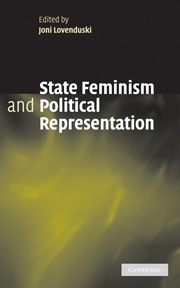Book contents
- Frontmatter
- Contents
- List of figures
- List of tables
- Notes on contributors
- Preface
- List of abbreviations
- 1 Introduction: state feminism and the political representation of women
- 2 Gendering political representation: debates and controversies in Austria
- 3 The Belgian paradox: inclusion and exclusion of gender issues
- 4 A politics for presence: state feminism, women's movements and political representation in Finland
- 5 Gendering the republican system: debates on women's political representation in France
- 6 WPAs and political representation in Germany
- 7 Gendering the debate on political representation in Italy: a difficult challenge
- 8 High tides in a low country: gendering political representation in the Netherlands
- 9 The women's movement, gender equality agencies and central-state debates on political representation in Spain
- 10 Party feminism, state feminism and women's representation in Sweden
- 11 Party government and women's representation debates: the UK
- 12 Women's policy agencies, the women's movement and representation in the USA
- 13 Conclusions: state feminism and political representation
- Appendix 1 Tables of women's representation in eleven countries
- Appendix 2 The RNGS model: summary of variable descriptors
- Index
- References
2 - Gendering political representation: debates and controversies in Austria
Published online by Cambridge University Press: 22 September 2009
- Frontmatter
- Contents
- List of figures
- List of tables
- Notes on contributors
- Preface
- List of abbreviations
- 1 Introduction: state feminism and the political representation of women
- 2 Gendering political representation: debates and controversies in Austria
- 3 The Belgian paradox: inclusion and exclusion of gender issues
- 4 A politics for presence: state feminism, women's movements and political representation in Finland
- 5 Gendering the republican system: debates on women's political representation in France
- 6 WPAs and political representation in Germany
- 7 Gendering the debate on political representation in Italy: a difficult challenge
- 8 High tides in a low country: gendering political representation in the Netherlands
- 9 The women's movement, gender equality agencies and central-state debates on political representation in Spain
- 10 Party feminism, state feminism and women's representation in Sweden
- 11 Party government and women's representation debates: the UK
- 12 Women's policy agencies, the women's movement and representation in the USA
- 13 Conclusions: state feminism and political representation
- Appendix 1 Tables of women's representation in eleven countries
- Appendix 2 The RNGS model: summary of variable descriptors
- Index
- References
Summary
Introduction
Historically, political representation in Austria was defined in terms of inclusion and exclusion. Exclusion corresponded with ethno-linguistic cleavages but was also based on class and gender. Class restrictions on men's voting were removed in 1907, and women were granted the right to vote and stand for election in 1918. Suffrage was now universal and equal, and elections free and secret. From 1918 to 1934 female MPs, especially from the highly organised and centralised women's working class movement, which was part of the Social Democratic Party, represented women as an interest group in decision-making bodies at federal and local levels. In 1934 the Christian Social Party abandoned its commitment to parliamentary democracy, and the parties of the left were outlawed. Between 1938 and 1945 Austria was part of the German Third Reich.
After the Second World War the party system was re-established. In the decades following the war political representation was primarily understood in terms of economic interest representation, and women's representation in parliament hovered around 6 per cent. It was not until the emergence and growth of the second wave of the women's movement that the political representation of women became an issue. In the late 1970s the movement called for a higher percentage of female MPs by linking descriptive representation to questions of substantive representation, and women's parliamentary representation began to increase up to 10 per cent. By 2003 the proportion of women MPs was 31.7 per cent.
- Type
- Chapter
- Information
- State Feminism and Political Representation , pp. 20 - 40Publisher: Cambridge University PressPrint publication year: 2005
References
- 3
- Cited by



